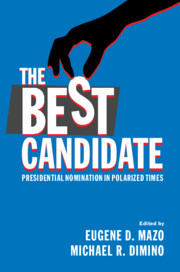Book contents
- The Best Candidate
- The Best Candidate
- Copyright page
- Dedication
- Contents
- Contributors
- Introduction
- 1 Presidential Selection: Historical, Institutional, and Democratic Perspectives
- 2 The Historical Development of the U.S. Presidential Nomination Process
- 3 Constitutional Law and the Presidential Nomination Process
- 4 Winnowing and Endorsing: Separating the Two Distinct Functions of Party Primaries
- 5 Simplifying Presidential Primaries
- 6 The Case for Standardizing Primary Voter Eligibility Rules
- 7 Primary Day: Why Presidential Nominees Should Be Chosen on a Single Day
- 8 A Eulogy for Caucuses
- 9 Floor Fight: Protecting the National Party Conventions from Manipulation
- 10 A Better Financing System? The Death and Possible Rebirth of the Presidential Nomination Public Financing Program
- 11 Campaign Finance Deregulation and the Hyperpolarization of Presidential Nominations in the Super PAC Era
- 12 Democratizing the Presidential Debates
- 13 The Influence of Technology on Presidential Primary Campaigns
- 14 Women and the Presidency
- 15 The Nomination of Presidential Candidates by Minor Political Parties
- 16 Reforming the Presidential Nominating Process: A Curmudgeon’s View
- Index
7 - Primary Day: Why Presidential Nominees Should Be Chosen on a Single Day
Published online by Cambridge University Press: 10 September 2020
- The Best Candidate
- The Best Candidate
- Copyright page
- Dedication
- Contents
- Contributors
- Introduction
- 1 Presidential Selection: Historical, Institutional, and Democratic Perspectives
- 2 The Historical Development of the U.S. Presidential Nomination Process
- 3 Constitutional Law and the Presidential Nomination Process
- 4 Winnowing and Endorsing: Separating the Two Distinct Functions of Party Primaries
- 5 Simplifying Presidential Primaries
- 6 The Case for Standardizing Primary Voter Eligibility Rules
- 7 Primary Day: Why Presidential Nominees Should Be Chosen on a Single Day
- 8 A Eulogy for Caucuses
- 9 Floor Fight: Protecting the National Party Conventions from Manipulation
- 10 A Better Financing System? The Death and Possible Rebirth of the Presidential Nomination Public Financing Program
- 11 Campaign Finance Deregulation and the Hyperpolarization of Presidential Nominations in the Super PAC Era
- 12 Democratizing the Presidential Debates
- 13 The Influence of Technology on Presidential Primary Campaigns
- 14 Women and the Presidency
- 15 The Nomination of Presidential Candidates by Minor Political Parties
- 16 Reforming the Presidential Nominating Process: A Curmudgeon’s View
- Index
Summary
Why do we have an Election Day but not a Primary Day? No aspect of the presidential nomination process causes as much controversy as the primary calendar. The calendar starts off in January or February and ends in June of each election year. A total of 57 states and territories hold their primaries and caucuses over the course of these months. The Iowa caucuses always start off the calendar, followed by the New Hampshire primaries. The results of these contests invariably eliminate some candidates and bestow momentum on others. Many more candidates participate in the first few presidential nomination contests than in the many later ones. As a result, disproportionate power is given to voters whose states hold early nomination contests, while the citizens of states with later nomination contests have less or sometimes no voice in choosing their party’s presidential nominee. In most years, a party’s presidential nomination contest ends months before citizens in the late-voting states have ever had a chance to cast their ballots. To gain more influence and a greater voice, a number of ambitious states have tried to move their primaries and caucuses forward, creating a phenomenon that has come to be known as “front-loading.”
Keywords
- Type
- Chapter
- Information
- The Best CandidatePresidential Nomination in Polarized Times, pp. 145 - 173Publisher: Cambridge University PressPrint publication year: 2020

